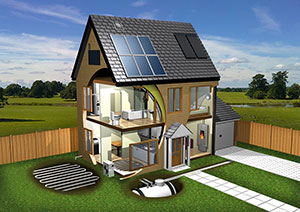Local authorities must take the lead on the next generation of sustainable housing
Author: Doug Johnson
There has never been more pressure on local authorities to provide more housing for our growing population, while at the same time preserving the natural beauty of our countryside. The tide of public opinion is now also turning on sustainability, and government and public alike are demanding that sustainably-built, low-impact eco-homes now need to be prioritised.
Despite genuine enthusiasm about sustainable building within local authorities, as well as amongst developers, there is often a huge knowledge gap about how low-impact eco-homes can actually be developed. In my work as a low-energy consultant, I often come across people who desperately want to be able to build ‘greenly’ but don’t have the first idea about where to start.
So, I have made a list of some of the key ‘do’s’ and ‘don’ts’ for local authorities looking to lead the way in sustainable development.
1. Do: Consult the experts early
No one is expecting local authorities to become experts on low-energy building overnight. However, this isn’t an excuse to continue with the building practices of the past. Low-energy experts need to be included in discussions about new developments from the beginning, in order to ensure that they not only deliver on sustainability goals, but also save money along the way.
There are also architects and developers out there who have experience building sustainable eco-homes, and wherever possible their expertise should be utilised. Building an experienced team is the first step towards achieving a successful eco-build. Using the wrong team can triple the cost of aspects of low-energy design and construction, and could set the sustainable building agenda back years!
2. Don’t: Just aim to meet Building Regulations
Too often with new-build developments, meeting the minimum Building Regulations is seen as a success. This mindset needs to change if we are going to successfully build a new generation of eco-homes. Local authorities need to lead the way in demanding that projects not only meet the minimum requirements, but exceed them, and these goals need to be clearly laid out at the planning and design stage.
3. Do: Prioritise sustainable design
One of the most important things to remember is that the greatest opportunity to reduce energy is through building location, orientation and form, using the power of physics in the natural environment, and through fabric element design.
The end user’s usage of the building only has a marginal effect on energy usage once the fabric and key technologies for the home have been implemented, so the design process is key. Sustainability can’t be an add-on only thought about at the end of a project, it needs to be an integral part of the development’s conception.
4. Don’t assume that sustainable buildings have to cost more
Poorly executed low-energy building projects have led many to assume that sustainable construction is more expensive. This doesn’t have to be the case. In low-energy home construction, experience counts for a lot and learning from others can prove invaluable in saving a project’s precious budget.
Expertly designed low-energy buildings can ensure that extra capital expenditure is offset through substantial running-cost savings and unlocking valuable government subsidies.
5. Do: Consider placement and transport links
The overall carbon footprint of a development can be massively impacted by how its inhabitants can travel to and from it. In the past, far too many new developments were built on the outskirts of towns with no thought given to public transport links, or amenities within walking distance. This has led to new developments being totally dominated by the car, and locked into a state of car-dependency for the foreseeable future.
The current generation of home-buyers is more environmentally aware than ever before, and local authorities need to give them the opportunities to live a more low-impact life.
The suggestions above are only the start, but they offer new way for local authorities and developers to start thinking about sustainable design of eco-home developments. There is so much government and public support for this new way of building, local authorities need to take the  first steps and show that they are leading the way.
first steps and show that they are leading the way.
About Doug Johnson
Doug is an independent energy consultant and founder of Mesh Energy. Over the past 12 years, he has worked on over 300 low energy home building projects, consulting with architects and their clients on how to design and build low energy projects, including initial ideas about building energy usage and fabric improvement, appropriate energy efficient product and technology selection, and detailed design and installation recommendations and tendering.
Mesh Energy, has delivered a 95% average CO2 reduction on its last 15 completed new build projects, and one of these builds could certainly work in your case study session. Doug also recently released his first book, 'Right First Time', a step-by-step guide on how to deliver modern low-energy homes.
https://www.mesh-energy.com/
- Log in to post comments













